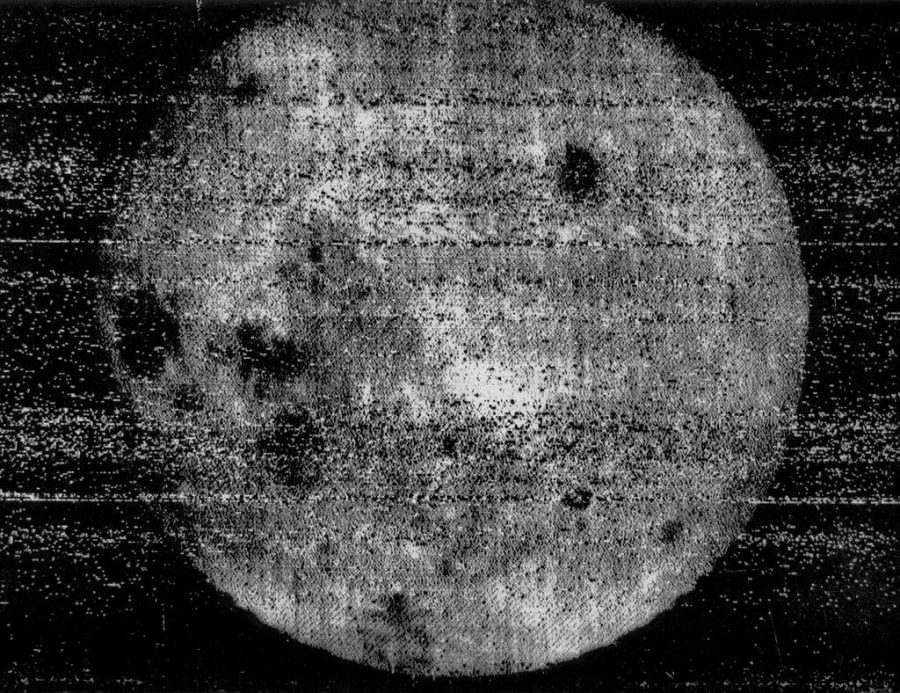[Most Recent Entries] [Calendar View]
Tuesday, November 5th, 2019
| Time | Event |
| 9:00a | The Very First Picture of the Far Side of the Moon, Taken 60 Years Ago
Sixty years ago, mankind got its very first glimpse of the far side of the Moon, so called because it faces away from the Earth. (And as astronomers like Neil DeGrasse Tyson have long taken pains to point out to Pink Floyd fans, it isn't "dark.") Taken by the Soviet Union, that first photo may not look like much today, especially compared to the high-resolution color images sent back from the surface itself by China's Chang’e-4 probe earlier this year. But with the technology of the late 1950s, even the technology commanded by the Soviets' then-world-beating space program, the fact that it was taken at all seems not far short of miraculous. How did they do it? "This photograph was taken by the Soviet spacecraft Luna 3, which was launched a month after the Luna 2 spacecraft became the first man-made object to impact on the surface of the Moon," explains astronomer Kevin Hainline in a recent Twitter thread. "Luna 2 followed Luna 1, the first spacecraft to escape a geosynchronous Earth orbit." Luna 3 was designed to take photographs of the Moon, hardly an uncomplicated prospect: "To take pictures you have to be stable on three-axes. You have to take the photographs remotely. AND you have to somehow transfer those pictures back to Earth." The first three-axis stabilized spacecraft ever sent on a mission, Luna 3 "had to use a little photocell to orient towards the Moon so that now, while stabilized, it could take the pictures. Which it did. On PHOTOGRAPHIC FILM." Even those of us who took pictures on film for decades have started to take for granted the convenience of digital photography. But think back to all the hassle of traditional photography, then imagine making a robot carry them out in space. Once taken Luna 3's photos "were then moved to a little CHEMICAL PLANT to DEVELOP AND DRY THEM." (In other words, "Luna 3 had a little 1 Hour Photo inside.") Then they continued into "a device that shone a cathode ray tube, like in an older TV, through them, towards a device that recorded the brightness and converted this to an electrical signal." You can read about what happened then in more detail at Damn Interesting, where Alan Bellows describes how the spacecraft sent "the lightness and darkness information line-by-line via frequency-modulated analog signal — in essence, a fax sent over radio." Soviet Scientists could thus "retrieve one photographic frame every 30 minutes or so. Due to the distance and weak signal, the first images received contained nothing but static. In subsequent attempts in the following few days, an indistinct, blotchy white disc began to resolve on the thermal paper printouts at Soviet listening stations." As Luna 3's photos became clearer, they revealed, as Hainline puts it, that "the backside of the moon was SO WEIRD AND DIFFERENT" — covered in the craters, for example, which have become its visual signature. For a modern-day equivalent to this achievement, we might look not just to Chang’e-4 but to the image of a black hole captured by the Event Horizon Telescope this past April — the one that led to an abundance of articles like "In Defense of the Blurry Black Hole Photo" and "We Need to Admit That the Black Hole Photo Isn’t Very Good." Astrophotography has come a long way, but at least back in 1959 it didn't produce quite so many takes. Related Content: Mankind’s First Steps on the Moon: The Ultra High Res Photos 8,400 Stunning High-Res Photos From the Apollo Moon Missions Are Now Online How Scientists Colorize Those Beautiful Space Photos Taken By the Hubble Space Telescope There’s a Tiny Art Museum on the Moon That Features the Art of Andy Warhol & Robert Rauschenberg The Glorious Poster Art of the Soviet Space Program in Its Golden Age (1958-1963) Wonderfully Kitschy Propaganda Posters Champion the Chinese Space Program (1962-2003) Based in Seoul, Colin Marshall writes and broadcasts on cities, language, and culture. His projects include the book The Stateless City: a Walk through 21st-Century Los Angeles and the video series The City in Cinema. Follow him on Twitter at @colinmarshall or on Facebook. The Very First Picture of the Far Side of the Moon, Taken 60 Years Ago is a post from: Open Culture. Follow us on Facebook, Twitter, and Google Plus, or get our Daily Email. And don't miss our big collections of Free Online Courses, Free Online Movies, Free eBooks, Free Audio Books, Free Foreign Language Lessons, and MOOCs. |
| 12:18p | Women Scientists Launch a Database Featuring the Work of 9,000 Women Working in the Sciences
“Why are there so few women in science?” has almost become a tiresome refrain over the years, given how little the answers engage with the thousands of female scientists working all over the world. “Too often,” writes the project 500 Women Scientists, “high-profile articles, conference panels, and boards are filled with a disproportionate number of male voices. News stories are reported by more men by a huge margin, and this imbalance is reflected in how frequently women are quoted in news stories unless journalists make a conscious effort to reach out. “Most keynote speakers at conferences are men. Panels are so frequently all-male that a new word evolved to describe the phenomenon: manels. These imbalances add up and reinforce the inaccurate perception that science is stale, pale and male.” The next time the question arises—“why are there so few women in science?”—or any other question needing scientific expertise, one need only gesture silently to 500 Women Scientists, a grassroots organization consisting of far more scientists than its title suggests. Described as “a resource for journalists, educators, policy makers, scientists and anyone needing scientific expertise,” the project began in 2016 as an open letter penned by its founders, then graduate students at Colorado University, Boulder, who decided to re-affirm their values against reactionary attacks by amassing 500 signatures on an open letter. They’ve since built a searchable database of over 9,000 women researchers from around the world, and a resource that helps build local scientific communities. Since launching last year, their Request a Scientist database has shown “the excuse that you can’t find a qualified woman just doesn't hold,” says co-founder and microbial ecologist Dr. Kelly Ramirez-Donders. It has also provided much more detailed data on women in science, which was published in a paper at PLOS Biology in April. “The group has ambitious plans to keep expanding its reach,” writes STAT. “They’re raising money to start a fellowship for women of color… and they have already launched an affiliate group, 500 Women in Medicine.” “We’re scientists. We’re lovers of evidence and data points,” says co-founder Maryam Zaringhalam, a molecular biologist. “And so now anytime somebody tells us they couldn’t find someone or there just aren’t enough women in STEM fields, we can point them to [the database] and say, ‘Well, actually, this is the tip of the iceberg, and there’s over 8,000.’… ensuring that women’s voices are represented in the media narratives is really essential for showing that, ‘No, we are here, it’s just that people haven’t necessarily been aware of us or done the work to find us.’” Correcting misperceptions not only helps reduce biases within scientific communities; it also encourages budding scientists who might otherwise be discouraged from the pursuit. “It’s not that girls are not interested in science,” co-founder Jane Zelikova tells Good Morning America. “Something happens where they don’t see women or girls represented as scientists and they don’t think it’s for them.” 500 Women in Science proves that notion wrong—science is for them, and for everyone who wants to devote their lives to scientific research. Just look at the data. Related Content: Real Women Talk About Their Careers in Science Josh Jones is a writer and musician based in Durham, NC. Follow him at @jdmagness Women Scientists Launch a Database Featuring the Work of 9,000 Women Working in the Sciences is a post from: Open Culture. Follow us on Facebook, Twitter, and Google Plus, or get our Daily Email. And don't miss our big collections of Free Online Courses, Free Online Movies, Free eBooks, Free Audio Books, Free Foreign Language Lessons, and MOOCs. |
| 5:15p | Watch J.S. Bach’s “Air on the G String” Played on the Actual Instruments from His Time There is no wrong way to listen to the music of Johann Sebastian Bach. You may prefer the austere, idiosyncratic piano interpretations of Glenn Gould; you may prefer the groundbreaking analog-synthesizer renditions painstakingly recorded by Wendy Carlos (whose early fans included Gould himself); or you may prefer faithful performances using only the instruments extant in the late 17th to mid-18th century period in which Bach lived. In that last case, the San Francisco early-music ensemble Voices of Music has you covered. You may remember us previously featuring their performances of Vivaldi and Pachelbel; in the video above, you can hear and see them play Bach. More specifically, you can hear them play the second movement, Aria, from Bach's orchestral suite in D Major, BWV 1068. The instruments they play it on include an Italian baroque violin from 1660 and an Austrian baroque viola from 1680, as well as more recently crafted examples rigorously modeled after instruments from that same era. "As instruments became modernized in the 19th century, builders and players tended to focus on the volume of sound and the stability of tuning," says VoM's explanation of their use of period instruments. "Modern steel strings replaced the older materials, and instruments were often machine made. Historical instruments, built individually by hand and with overall lighter construction, have extremely complex overtones — which we find delightful." Any lover of Bach's music has heard this piece many times, not least due to its popularization in the late 19th century, in an arrangement by German violinist August Wilhelmj, as "Air on the G String." The original work dates to "some time between the years 1717 and 1723," writes music blogger Özgür Nevres, when Bach composed it for his patron Prince Leopold of Anhalt. It also holds the honor of being the first work by Bach ever recorded, "by the Russian cellist Aleksandr Verzhbilovich and an unknown pianist, in 1902 (as the Air from the Overture No. 3 in D major, BWV 1068)." But no matter how many different recordings from different eras of Bach's orchestral suite in D Major in which you've steeped yourself, if you've only heard it played on modern instruments, a performance like Voices of Music's shows that it still has surprises to offer. Related Content: Watch Glenn Gould Perform His Last Great Studio Recording of Bach’s Goldberg Variations (1981) All of Bach for Free! New Site Will Put Performances of 1080 Bach Compositions Online How a Bach Canon Works. Brilliant Based in Seoul, Colin Marshall writes and broadcasts on cities, language, and culture. His projects include the book The Stateless City: a Walk through 21st-Century Los Angeles and the video series The City in Cinema. Follow him on Twitter at @colinmarshall, on Facebook, or on Instagram. Watch J.S. Bach’s “Air on the G String” Played on the Actual Instruments from His Time is a post from: Open Culture. Follow us on Facebook, Twitter, and Google Plus, or get our Daily Email. And don't miss our big collections of Free Online Courses, Free Online Movies, Free eBooks, Free Audio Books, Free Foreign Language Lessons, and MOOCs. |
| << Previous Day |
2019/11/05 [Calendar] |
Next Day >> |


